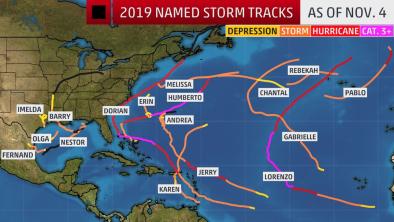Science Source
Tropical Cyclones and Climate Change Assessment: Part I
- Looks at whether changes in tropical cyclone activity can be detected compared to natural variability and/or attributed to human-caused climate change
- Assesses the evidence for detectable anthropogenic influence on tropical cyclone activity while seeking to reduce the chance of Type II errors (i.e., missing or understating anthropogenic influence or detection)
- For a change to be considered detectable from the Type II error perspective, the authors adopt the criteria of p=0.1 (less than 1 in 10 chance of being wrong) for statistical significance and also assess whether the balance of evidence suggests that a detectable change has been identified
- Attribution statements made from the Type II error perspective indicate the authors found there is a balance of evidence (more than 50% chance) that anthropogenic climate change contributed nontrivially in a specified direction to an observed change
NOTE: all the statements below are from a Type II perspective requiring less convincing levels of evidence
- All authors agree there is a detectable poleward migration of the lifetime maximum intensity of cyclones in the western North Pacific, and most (9 out of 11) agree human-caused climate change contributed to the migration
- Ten out of 11 authors conclude the balance of evidence suggests there is a detectable increase in the global average intensity of the strongest tropical cyclones since the early 1980s; eight of 11 say humans contributed to the increase
- Eight of 11 authors concluded that the balance of evidence suggests an anthropogenic contribution to the 2015 western North Pacific TC season
- All authors concluded that the balance of evidence suggests there has been a detectable long-term increase in occurrence of Hurricane Harvey-like extreme precipitation events in the eastern Texas region, and that human-caused global warming has contributed to this increase
- All authors found the balance of evidence suggests an increase in the frequency of post-monsoon season extremely severe cyclone storms over the Arabian Sea, and most authors (eight of 11) say human-caused warming has contributed to the increase
- All authors concluded that the balance of evidence suggests the observed increase in Category 4-5 proportion in recent decades represents a detectable change; most (eight of 11) concluded the increase resulted in part from human-caused warming
Related Content
Headline

Nov 6, 2019 | Weather Underground
As 2019's Hurricane Season Winds Down, Here Are 7 of the Craziest Things We Saw
Headline

Oct 28, 2019 | Washington Post
Oddball Hurricane Pablo developed farther east than any Atlantic tropical cyclone on record
Headline

Oct 22, 2019 | The Weather Channel
Atlantic Hurricane Scorecard: After Nestor, Here's How the 2019 Season Measures Up
Science Source
| World Weather Attribution
Rapid attribution of the extreme rainfall in Texas from Tropical Storm Imelda
Geert Jan van Oldenborgh, Karin van der Wiel, Sjoukje Philip & Sarah Kew


